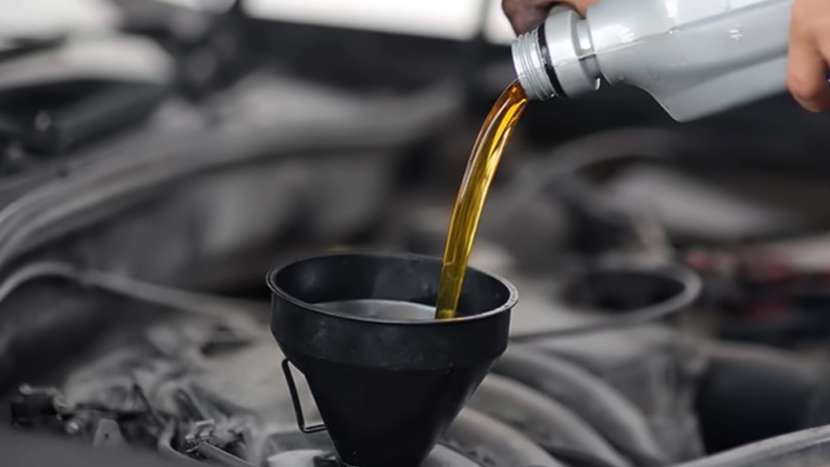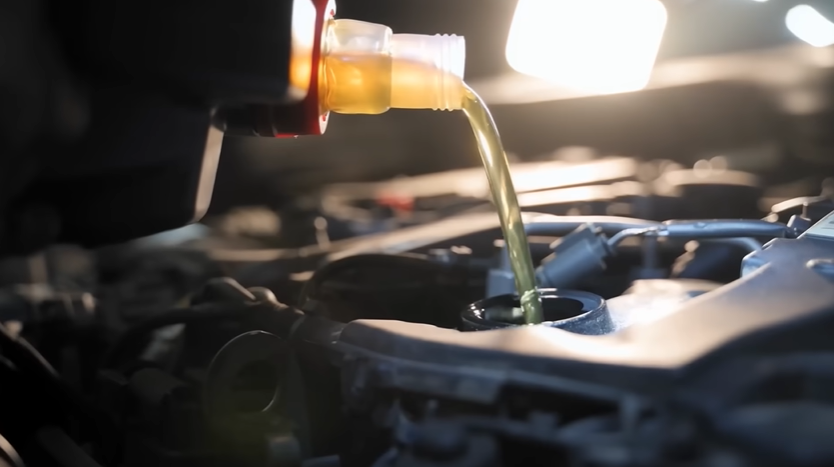A transmission oil cooler helps to keep the transmission fluid cool, which in turn keeps the transmission from overheating. There are two main types of transmission oil coolers: air-cooled and liquid-cooled. Air-cooled transmission oil coolers are typically less expensive than liquid-cooled ones, but they are not as effective at cooling the fluid.
Liquid-cooled transmission oil coolers are more expensive, but they do a better job of cooling the fluid. To install a transmission oil cooler, first determine which type of cooler you need (air-cooled or liquid-cooled). Then, follow the specific instructions for that type of cooler.
Generally speaking, you will need to mount the cooler in a location where it will get good airflow (for an air-cooled cooler) or have access to a water source (for a liquid-cooled cooler). Once the cooler is mounted, connect the hoses according to the instructions. Make sure all connections are tight and there are no leaks before operating your vehicle.
- The first step is to find a suitable location for the transmission oil cooler
- It is important to ensure that the cooler will not be obstructed by any other engine components and that there is enough space around it for air to circulate
- Once a location has been chosen, the next step is to install the brackets that will support the transmission oil cooler
- These brackets can be mounted to the engine block or frame using bolts or screws
- The next step is to connect the transmission oil lines to the cooler
- In most cases, this will require cutting and splicing the existing lines
- It is important to take care not to damage the lines while doing this
- Finally, once all connections are made, it is time to fill up the transmission with fresh oil and test drive the vehicle to check for leaks

What is the Best Way to Mount a Transmission Cooler?
There are many different ways to mount a transmission cooler, but the best way is to use an aftermarket transmission cooler kit. This will give you all the necessary parts and instructions for properly mounting your transmission cooler. It is important to follow the instructions carefully so that you do not damage your vehicle or cause any leaks.
Does It Matter Which Line Goes Where on a Transmission Cooler?
Yes, it does matter which line goes where on a transmission cooler. The inlet and outlet lines are not interchangeable. If they are swapped, the transmission will overheat and be damaged.
How Much Does It Cost to Install a Transmission Oil Cooler?
Installing a transmission oil cooler is not as expensive as one might think. The cost of the transmission oil cooler itself is relatively inexpensive, and the installation process is not overly complicated. That said, the total cost of installing a transmission oil cooler will vary depending on the specific vehicle and the chosen method of installation.
The most important factor in determining the cost of installing a transmission oil cooler is the type of vehicle being worked on. Many newer vehicles come equipped with transmission oil coolers from the factory, so adding an aftermarket unit may be unnecessary. Additionally, some vehicles may require special tools or equipment for installation, which can add to the overall cost.
For most vehicles, however, the basic tools needed for installation are readily available and relatively inexpensive. The second major factor affecting the cost of installing a transmission oil cooler is the chosen method of installation. The most straightforward method is simply bolting an aftermarket unit onto existing mounting points under the hood.
This usually requires no special tools or equipment and can be completed in an afternoon with basic mechanical skills. Other methods of installation, such as running new lines through existing ductwork, may take longer and require more specialized tools and knowledge. In any case, choosing a reputable professional to complete the installation will ensure that it is done correctly and will help keep costs down.
In conclusion, while there are several factors that can affect the cost of installing a transmission oil cooler, it is generally a fairly inexpensive project that can be completed relatively easily by someone with basic mechanical skills.
Do You Need a Transmission Cooler?
If you’ve ever wondered whether or not you need a transmission cooler, wonder no more! We’re here to give you the lowdown on transmission coolers and help you decide if one is right for your vehicle. First, let’s start with the basics.
A transmission cooler is a device used to cool automatic transmission fluid in order to keep the transmission operating at optimal temperatures. Transmission fluid can break down when it gets too hot, leading to decreased performance and increased wear and tear on your transmission. A transmission cooler helps prevent this by dissipating heat away from the fluid as it circulates through the cooler.
There are a few different types of transmission coolers available on the market, but the most common is an air-cooled cooler. These work by circulating air around the fins of the cooler to dissipate heat. Another type of cooler is a liquid-cooled cooler, which uses either water or oil to transfer heat away from the transmission fluid.
Liquid-cooled coolers are typically more effective than air-cooled ones, but they can be more expensive and require more maintenance. So, do you need a transmission cooler? If you frequently tow heavy loads or drive in hot weather conditions, then a transmission cooler is a good idea.
It will help prolong the life of your transmission and keep it running at peak performance levels. Even if you don’t fall into one of those categories, though, a transmission cooler can still be beneficial – particularly if your vehicle came equipped with an undersized or inadequate factory cooling system. No matter what type of vehicle you have or how often you use it, keeping your transmission properly cooled is essential for maintaining its health and longevity.
If you’re still not sure whether or not a Transmission Cooler is right for your needs, feel free to contact us – we’d be happy to help guide you in making the best decision for your specific situation!
The ‘Right’ Way To Install a Transmission Cooler
Transmission Oil Cooler Kit
A transmission oil cooler kit is a great way to keep your transmission cool, especially if you live in a hot climate or do a lot of towing. The kit includes an oil cooler, hose, fittings, and hardware. It’s easy to install and is a great way to protect your investment.
Bypass Radiator Transmission Cooler Or Not
There are many factors to consider when deciding whether or not to bypass your radiator transmission cooler. The most important factor is the climate you live in. If you live in a hot climate, it is essential to have a transmission cooler because the heat can cause your transmission fluid to break down, leading to transmission problems.
However, if you live in a cold climate, you may not need a transmission cooler because the fluid will not break down as quickly in the cold weather. Other factors to consider include how often you drive and how hard you use your vehicle. If you frequently drive or use your vehicle for heavy-duty tasks, it is also necessary to have a transmission cooler because the extra strain on the system can cause the fluid to break down more quickly.
Ultimately, it is up to you to decide whether or not bypassing your radiator transmission cooler is right for you and your vehicle.
Transmission Cooler Mounting Position
When it comes to transmission coolers, there are a few different ways that they can be mounted. The most common way is to simply mount the cooler in front of the radiator. This ensures that the air flowing through the radiator will also flow through the transmission cooler, helping to keep your transmission fluid nice and cool.
Another option is to mount the transmission cooler behind the radiator. This can be beneficial as it keeps the transmission fluid away from any potential engine heat sources. However, it’s important to ensure that there’s still enough airflow over the cooler so that it can do its job properly.
Finally, some people choose to install an auxiliary transmission cooler alongside their regular one. This provides even more cooling capacity for those who are looking to keep their transmission fluid extra cool. No matter which mounting position you choose for your transmission cooler, make sure that it’s installed properly and securely so that it can do its job effectively.
How to Install Transmission Cooler Lines to Radiator
If you’re looking to install transmission cooler lines to your radiator, there are a few things you need to know. First, make sure the vehicle is parked on level ground and the engine is turned off. Next, locate the transmission fluid fill tube and unscrew the cap.
Once the fluid starts draining, have a catch pan ready to collect it (you can reuse this fluid). Now would also be a good time to check for any leaks in the system. Once the fluid has finished draining, find the transmission cooler lines at the front of the engine bay and disconnect them from the radiator.
You may need to use a pair of pliers to loosen/remove the hose clamps that are securing them in place. With those disconnected, you can now remove the old transmission cooler lines from the vehicle. To install new Transmission Cooler Lines: start by threading one end of each line into its respective opening on the radiator (the larger line goes into the upper opening).
Then, take the other end of each line and connect it to their respective fittings on your transmission(again, the larger line goes into the upper fitting). Make sure all connections are tight so there are no leaks. Finally, reattach any hoses or clamps that were removed earlier and screwthetransmissionfluidfill tubecapback on.
Check for any leaks one more time before starting up your engine – if everything looks good, then you’re all set!
Conclusion
Installing a transmission oil cooler is a smart upgrade that can significantly extend the life of your transmission, especially under heavy-duty driving conditions like towing or frequent stop-and-go traffic.
By carefully selecting the right cooler for your vehicle, gathering the necessary tools, and following a step-by-step installation process—mounting the cooler, connecting the lines, and ensuring leak-free operation—you enhance both performance and reliability.
While the task requires some mechanical knowledge and patience, the long-term benefits of improved transmission health and vehicle efficiency make it a worthwhile investment. With your cooler installed, your transmission is now better protected against heat and ready to take on the road ahead.



Leave a Reply